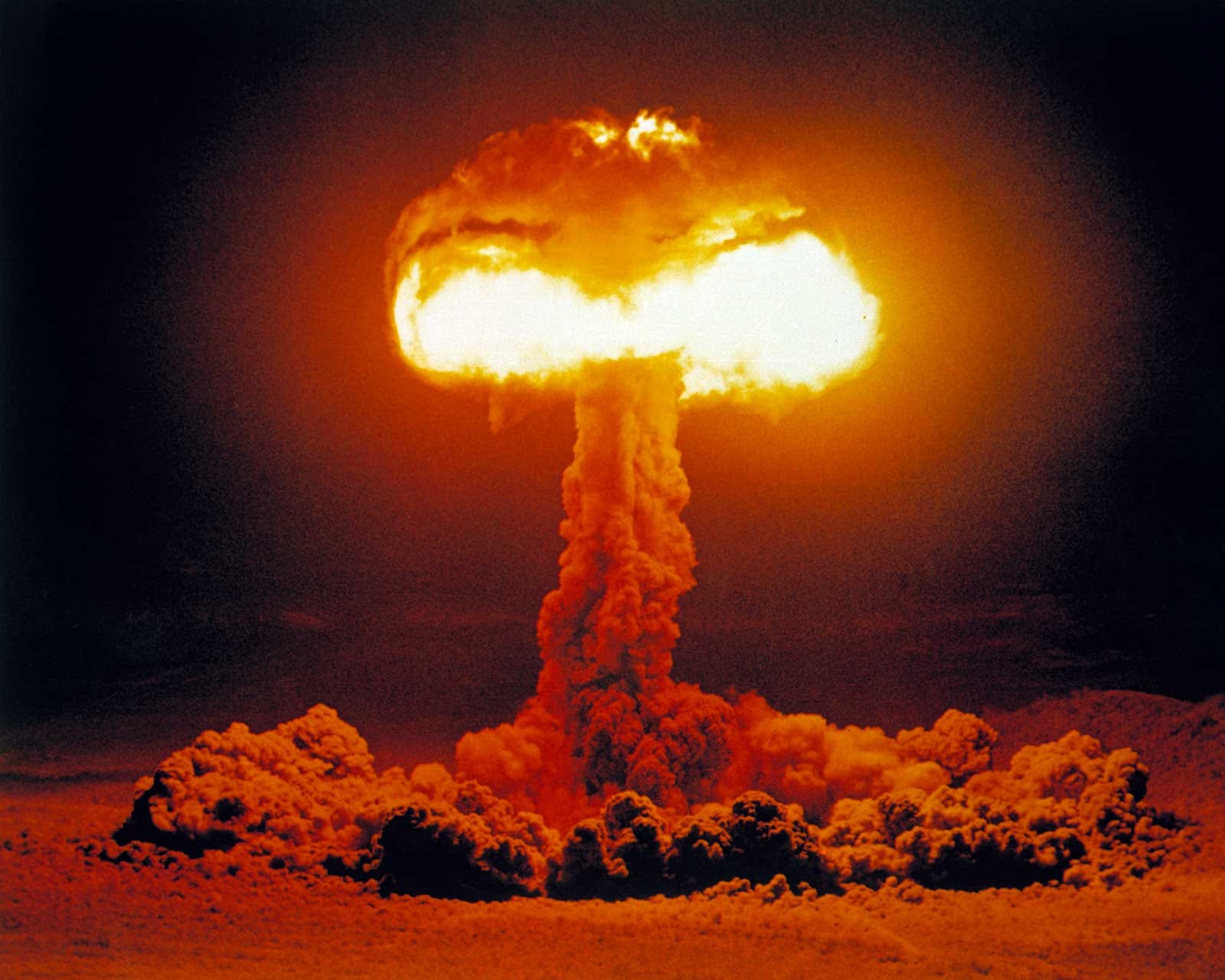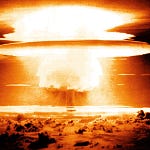Dear Permission to be Powerful Reader,
It didn’t happen overnight…
The unthinkable catastrophe that left America in ruins was years in the making…
Telegraphed by ominous warnings and willful ignorance.
By 2025, cracks were already visible in the nation’s foundation.
Geopolitical tensions were at a boiling point…
Climate disasters hammering the coasts…
And lunatics controlled the keys to power.
Experts sounded the alarm:
A 40% chance of a new world war by the 2030s
Many warned, likely involving the United States, China, and other major powers.
Some even cautioned we had entered a “period of maximum danger”
A volatile phase, where the slightest spark could ignite a global conflict.
But America’s leaders and citizens, distracted and divided, failed to heed the signs.
As China surged ahead economically and militarily.
Surpassing the U.S. in raw industrial might…
The balance of power teetered dangerously.
Military analysts noted that the U.S. could “no longer deter China,” and the risk of a third world war was rising.
Beijing’s ambitions had grown bold, and Washington’s resolve had grown brittle.
Meanwhile, climate scientists delivered their dire bulletins:
Earth’s vital signs were flashing red, and “the future of humanity hangs in the balance,” a global coalition of experts declared in late 2024.
Year after year of record heat, megastorms, and wildfires signaled that we had entered a “critical and unpredictable new phase of the climate crisis , one that threatened food and water supplies, infrastructure, and ultimately social stability.
Intelligence officials quietly concurred.
A once-classified National Intelligence Assessment warned that while climate change alone might not topple nations, it would exacerbate poverty, social tensions, environmental degradation, and “ineffectual leadership”, potentially pushing fragile societies over the edge.
America was not immune to these pressures; indeed, it was hurtling straight into them.
Politically, the United States had become a house divided against itself – and against common sense.
In this worst-case scenario, dysfunction reigned in Washington. A celebrity businessman-turned-populist demagogue found himself back in the Oval Office after the 2024 elections, doubling down on the grievance-fueled chaos of his previous term. His appointments to critical posts proved disastrous.
The Department of Defense fared no better.
The Commander of U.S. forces was a four-star general with a three-bottles-a-day habit, a volatile alcoholic known more for barroom brawls than battlefield brilliance.
Together, this leadership trifecta was a ticking time bomb at the helm of a superpower, just as the fuse of global crisis burned down. The stage was set. All it would take was a flash and a boom to send the whole edifice tumbling down.
That flash came in the spring of 2026
Historians may debate the exact trigger – a showdown over Taiwan, a skirmish in the South China Sea, a miscalculation in Eastern Europe – but the outcome was undeniable.
World War III had arrived on America’s doorstep, and the American Century came to a sudden, violent end.
This is the story of those harrowing days and the long night that followed.
It is a story of a nation brought to its knees by external attack and internal rot, a cautionary tale told in blood and desperation.
What follows is a gripping exposé of the collapse of the United States – written to warn you, to shock you, and to inform you of just how close we stand to the abyss.
On a gray April morning, the first shots of World War III rang out.
News broke (for those still watching the news) that Chinese forces had moved on Taiwan, and within hours, U.S. and allied military assets were fully engaged.
What began as a regional conflict escalated with blinding speed. Beijing and Washington traded blows in the Western Pacific – fighter jets downed, warships sunk – and neither side blinked.
In Moscow, where anti-American fervor had reached a fever pitch, the Kremlin seized its chance.
Russia opened a second front in Europe, striking NATO positions in Eastern Europe and threatening to use nuclear arms if the West intervened.
A new Axis of authoritarians had formed, with China, Russia, North Korea, and Iran coordinating their moves.
The United States suddenly found itself fighting a multifront war against nuclear-armed adversaries – the nightmare scenario strategists had long feared.
Then the unthinkable happened. In minutes, the war leapt from conventional to nuclear.
Satellite early-warning systems detected it: three high-altitude bursts above North America – nuclear detonations in space. At first, there were no obvious explosions on the ground.
But everything electric suddenly went dark.
From New York to Los Angeles, the grid collapsed in an instant as electromagnetic pulse (EMP) waves fried circuits and transformers.
It was a coordinated EMP attack, likely delivered by a stealth launch of specialized warheads lofted over the United States. In military terms, it was a decapitation strike aimed at blinding the nation and sending it back to the Stone Age before any larger nuclear exchange.
“One nuclear weapon could take out the electric grid and all of the other critical life-sustaining infrastructures and kill up to 90% of the population,” expert Dr. Peter Vincent Pry had warned years prior.
Now those words were no longer hypothetical. They were America’s reality.
Moments later, hell arrived on Earth. Sentries on U.S. coasts reported blinding flashes on the horizon.
Partial nuclear strikes were underway. Ballistic missiles – launched from submarines lurking offshore or from covert container ships – slammed into their targets.
Major coastal cities were annihilated in nuclear fire. The Eastern Seaboard saw New York City and Washington, D.C. engulfed in mushroom clouds. The Western coast: Los Angeles and San Francisco were hit in quick succession.
In an eerie echo of Cold War predictions, Washington was among the first targets – the enemy knew that “the Pentagon, White House, Congress… are based in this city”, and they meant to obliterate America’s leadership in one blow.Eight major cities, including New York, Los Angeles, and San Francisco – financial and cultural hubs – were likewise on the predetermined hit list.
And the carnage did not stop at America’s shores. Almost simultaneously, allied capitals in Europe felt the wrath: London was scorched by a nuclear blast, Paris and Berlin suffered strikes of their own. The attackers’ message was clear: the old Western order was to be brought to its knees in a single day of fire.
In Manhattan, a silent bright flash was followed by a blast wave that leveled skyscrapers and ignited a firestorm.
A one-megaton warhead detonated over the city’s heart, releasing a flash of heat “four to five times greater than the centre of the sun”.
Glass vaporized, steel melted.
Within seconds, hundreds of thousands were dead. Those who survived the initial flash were tossed like ragdolls by a wall of superheated wind. A towering mushroom cloud rose above the burning city, its boiling black rain carrying radioactive ash.
The same scenes played out in Los Angeles: the Hollywood Hills turned to cinders, the freeways filled with charred wreckage of cars, and a pall of smoke that could be seen for a hundred miles. It was not all-out nuclear Armageddon – the heartland of America was, for the moment, spared direct hits.
The attackers had restrained themselves just enough to avoid an automatic full U.S. retaliation (perhaps calculating that crippling the U.S. was sufficient to win). But the damage was done.
In a matter of hours, the United States had been decapitated and disarmed.
Its major cities were in flames, its communications severed, its government in disarray.
While coastal cities burned, the rest of the country was plunged into darkness and silence. The EMP blasts – electromagnetic pulses from those high-altitude nuclear detonations – were an invisible dagger through the heart of America’s critical infrastructure. Every unprotected electronic device from coast to coast simultaneously blinked off.
The nation’s electric grid, a vast and aging web of high-voltage lines and transformers, was fried in an instant. Power plants went offline. Transmission stations sparked and died.
The entire continental United States, apart from isolated pockets, experienced a total blackout. In that moment, an advanced 21st-century society was yanked backward in time at least a century.
Airliners fell from the sky, their avionics dead. Modern cars stalled on the highways – their computer systems scrambled, leading to chain-reaction crashes on every major thoroughfare. Hospital emergency generators kicked on, only to sputter out hours later when fuel ran dry or circuitry failed.
Within seconds of the EMP, millions of people were trapped.
In elevators between floors, in subway tunnels deep below city streets, in pitch-black offices and homes on a suddenly unpowered planet. America had gone dark, literally and figuratively.
Emergency responders struggled to make sense of the chaos, but their radios were down, and 911 call centers were silent. The federal government’s communications were severed; the president’s tweets (his preferred mode of address) were now as useless as the phones people stared at in shock. For a critical window, the nation had no idea what was happening to it.
A lucky few with old transistor radios or EMP-hardened equipment caught fragments of transmissions – frantic Emergency Alert System broadcasts and ham operators relaying pleas for information.
But for most, there was only confusion. In the void, rumors and fear filled the vacuum. Was it an attack? An asteroid? God’s wrath? No one knew for sure in those first hours.
Engineers and security experts had warned for years that the U.S. electrical grid was fatally vulnerable to EMP, whether from a nuclear blast or even a massive solar flare. The outcome of an EMP-induced blackout had been described in almost apocalyptic terms in congressional testimonies.
A single high-altitude nuclear explosion could “destroy the U.S. electrical grid… resulting in societal collapse” and potentially the deaths of 90% of the population within a year.
No food, no water, no transportation, no internet – everything would grind to a halt. Now those dry predictions were an on-the-ground reality. In an instant, the USA was kicked back to the 19th century, but without the resiliency and know-how that our 19th-century forebears possessed.
As the EMP’s impact resonated, transformers blew out in showers of sparks. The few power plants that survived automatic shutdown were islands in a sea of darkness, unable to transmit electricity to anyone.
The entire national power grid had collapsed, and experts knew it would take many months or years to repair – if the nation even had that long.
In one blinding flash, Americans had lost what many believed could never fail: the invisible currents that made every aspect of modern life possible. The thin veneer of civilization was about to be brutally stripped away.
The first 72 hours after the collapse were sheer pandemonium. In disaster planning scenarios, emergency managers often talk about the “golden 72 hours” – the critical window to get relief to a stricken area before chaos erupts.
But what happens when the disaster is everywhere, all at once? The answer: civilization fractures with frightening speed. One British study famously concluded that modern societies are “nine meals away from anarchy.”
In other words, just three days without food on supermarket shelves is enough to break down law and order.
America was about to learn how true this was, the hard way.
Hour 0-24: In the first day, people’s initial shock turned to survival instinct. Neighbors helped neighbors at first – candlelit gatherings in apartment hallways, pooling bottled water and food, reassuring the frightened children as best as possible.
But as the reality sank in – no lights, no phones, no ambulance coming – fear took hold. In cities that hadn’t been nuked but were dark, the nights became eerily silent and then explosively noisy. Looting and lawlessness began within hours of the blackout.
In New York (the parts of the metropolis not reduced to radioactive rubble) and in Chicago, Atlanta, Dallas – reports of break-ins and mob theft spread like wildfire.
During the 1977 NYC blackout, there had been widespread looting in 31 neighborhoods with over 1,600 stores ransacked and a thousand fires set.
That was just a single night with the power out. Now imagine an entire nation without power: the veneer of civilization shattered almost immediately. Pharmacies and grocery stores were the first targets – desperate or opportunistic crowds emptied them of medicine and food by nightfall of Day 1.
Gunshots rang out in the dark as store owners and police tried, and largely failed, to stave off the chaos. In some places, police simply didn’t show up – they were overwhelmed or prioritizing their own families’ safety. The thin blue line evaporated.
Hour 24-48:
By the second day, panic had fully set in. Highways out of the big cities jammed with vehicles, many of which soon ran out of gas or were blocked by accidents.
Millions of people were now on foot, fleeing urban centers in search of safety, functioning utilities, or rumors of aid. They became refugees in their own country – trudging along interstate shoulders with backpacks and children in tow, the lucky ones pushing wheelbarrows of whatever supplies they’d grabbed.
With the federal government effectively mute and blind, wild conspiracy rumors took hold: some whispered that the blackout was a permanent new reality, others that this was a prelude to an invasion and that foreign paratroopers would descend from the skies at any moment.
Tragically, the latter wasn’t entirely paranoia – in the confusion, special forces units from hostile powers did infiltrate key sites, sabotaging what little infrastructure remained.
At a West Virginia power substation, unidentified commandos blew up transformers that technicians were frantically trying to jury-rig. Outside a major telecom hub, snipers picked off engineers attempting to restore communication lines. America was under sustained attack, and couldn’t even coordinate a response.
Meanwhile, within 48 hours, critical supplies ran dangerously low. Hospital fuel tanks for generators were almost dry, forcing doctors to make grim choices.
Intensive care units went black, and the sick and elderly began to die in rising numbers as ventilators stopped and medications spoiled without refrigeration.
In the suburbs and countryside, gas station pumps had no power to operate; whatever fuel people hadn’t already pumped before the EMP was now inaccessible.
In a desperate attempt to get fuel flowing, some tried hand-siphoning gas from station tanks, leading to poisonous fumes and fatal accidents.
Clean water also became a concern: city water systems lost pressure once electric pumps failed. Taps ran dry, and people resorted to gathering water from rivers, ponds, even drainage ditches – a recipe for disease.
48-72 Hours:
By the third day, society hit the breaking point. Food in refrigerators was spoiled. Store shelves were stripped bare. Panic and hunger overtook decency and order.
“Britain… is only 72 hours from chaos,” wrote one analyst looking back at disasters – and the same held true for America.
In many neighborhoods, roving gangs formed – some simply desperate families banding together to forage what they could; others more violent opportunists, armed and ready to take by force.
Gunfire became a constant at night. In rural areas, gun owners stood guard on porch fronts, defending their homes from looters coming from the cities. In the cities, fires burned unchecked – the fire departments were stretched to the breaking point, often unable to drive to blazes for lack of fuel or blocked streets.
In the nuclear strike zones, of course, there was nothing to be done for the infernos; they raged until they ran out of rubble to consume. But even in the untouched cities, now every night was a mini-apocalypse of flames and lawlessness.
National Guard units, themselves struggling without communications, were deployed in some states and tried to enforce curfews.
In a few cases they managed to keep a semblance of order in downtown cores, but elsewhere they found themselves outnumbered and under fire.
Martial law was declared in dozens of states by panicked governors – but declaring martial law and enforcing it are two very different things.
Amid the mayhem, the federal government’s leadership was effectively paralyzed. President Trump, who had been rushed to a secure bunker when the nukes flew, attempted to address the nation – but with TV, radio, and internet largely down, his voice hardly reached anyone.
Those who did later recount his bunker broadcast say it was a surreal, rambling mixture of defiance and denial: he congratulated himself on having “seen this coming” (he hadn’t), blamed his political opponents for weakening the country, and vowed revenge on China.
Meanwhile, his top general – inebriated and emotionally unstable – ordered military units to “hold at all costs” without any clear plan or support, then reportedly fell into a stupor at a critical moment.
The Secretary of Health (the conspiracy theorist who had somehow gotten the job) was no better: he dismissed the unfolding public health disaster, claiming on an emergency call with state officials that “the people dying in hospitals were probably crisis actors” and that everyone should remain calm and await further instructions.
Dysfunction and delusion reigned at the highest levels as America burned and bled.
Throughout that hellish 72-hour window, millions of Americans came to a grim realization: Help was not on the way. They were on their own. The social contract – that thin agreement that we will behave ourselves because help will come and order will be maintained – was irretrievably broken. In its place came the raw, ancient law of survival.
In some areas, that meant neighbors forming community defense groups – arming themselves with whatever they had, organizing watch rotations at night, pooling resources to care for kids and the infirm.
In other areas, it meant the rise of warlords: local gang leaders or even business owners who used private security to secure a perimeter and impose their own rule. By the end of the third day, the United States as a unified, functioning society had ceased to exist. The great collapse had arrived.
Blighted Coasts and Burning Cities
While the interior descended into chaos, the coastal regions suffered a double catastrophe: not only was the grid down and order collapsing, but they also had to contend with the direct effects of nuclear attack. The immediate death toll in the blast zones was staggering.
New York City – once home to over 8 million souls – was now a charred tomb for a huge portion of its population.
Those who survived the initial blast and heat found themselves in a nightmare landscape. Ground Zero in Manhattan was nothing but a crater of radioactive mud where Midtown once stood. Surrounding it for miles, the city was ablaze.
The few buildings still standing were gutted by fire and blasted free of glass, their steel skeletons twisted. On the streets, the injured lay in heaps, many blinded by the flash or with skin hanging off their bodies from the thermal pulse.
With hospitals destroyed and almost no medical aid available, the suffering was unimaginable. A pall of smoke and radiation hung over the metropolis, slowly drifting with the winds across Long Island and into New Jersey.
Washington, D.C. fared no better.
The nuclear strike on the capital decapitated the federal government in an instant – incinerating thousands of government officials, military officers, and civilians alike.
The White House was vaporized; the Capitol collapsed into a burning heap. The iconic monuments – Lincoln, Washington, Jefferson – were reduced to unrecognizable chunks of marble.
In the Pentagon’s deep bunker, some of the military’s leadership survived, only to emerge into a smoldering ruin of what was once the nerve center of U.S. defense.
They quickly discovered that most of their colleagues and chain-of-command were simply gone. The nation’s capital was now a grave.
On the West Coast, Los Angeles and San Francisco were similarly devastated. In Los Angeles, the bomb’s fireball ignited a gasoline inferno – miles of cars stuck in perpetual traffic became fuel for an enormous blaze that swept outward.
The city of Hollywood’s dreams turned into a vision of hell: burning palm trees and melting roadways, with survivors stumbling through toxic smoke under an orange-black sky.
San Francisco’s downtown was flattened, the Golden Gate Bridge twisted and partially collapsed into the bay. Fires merged into a firestorm that consumed whole neighborhoods.
Those trying to flee the city found the bridges destroyed and roads impassable. Many perished in place; others crowded onto any boats they could find, desperate to escape the irradiated hellscape by water.
And then there was the radiation.
These were relatively limited nuclear strikes – “partial” by the grim calculus of war – but they were enough to blanket large areas in fallout.
The wind carried radioactive ash inland. Within 12-24 hours of the blasts, deadly fallout began to dust down on areas far from the immediate targets. Cities like Philadelphia, Boston, and Seattle, which had escaped direct hits, now faced a different menace: invisible, cancerous poison settling on rooftops and in water supplies.
People unaware of the danger went outside to gape at the distant mushroom clouds or to search for missing loved ones, unknowingly exposing themselves to radiation.
In the absence of clear instructions (the emergency broadcast network in many areas was off-air due to EMP), many did not know to shelter or how to protect themselves. By the time word spread via word-of-mouth that “a radioactive cloud is coming,” it was often too late.
Europe, too, was in agony.
London’s strike was centered near the Thames; the blast cratered parts of Westminster.
The UK’s government was decimated in a flash not unlike D.C.’s fate. Paris saw a tactical nuke airburst over the Defense district, and Berlin suffered a strike on its outskirts (the bomb intended for the city center fell slightly off target but still wreaked havoc).
Scenes of mass panic and flight erupted across European cities as well. A dark irony played out: for years, European civil defense had atrophied, but some places hastily reopened Cold War-era bunkers as the nuclear threat re-emerged.
A few thousand people in cities like Prague or Helsinki survived in deep shelters while the world above burned.
But for most, there was no refuge except a basement or subway tunnel – scant protection from the grim cocktail of blast, fire, and radiation.
By the end of the first week, the once-bright coasts of the United States were effectively “blighted zones.” Survivors in these areas faced extreme hardships.
They not only lacked power and food, like the rest of the country, but also had to contend with radiation sickness.
By Day 3-4, symptoms began: nausea, vomiting, bleeding gums, hair falling out in clumps.
There was no medicine to give – the Strategic National Stockpile of emergency meds might as well have been on the moon for all the ability to distribute it.
In a bitter twist, some of the public health leadership (what was left of it) was urging people to take iodine tablets to protect their thyroids from radiation – but such advice was useless when the pills couldn’t be communicated or delivered at scale.
The so-called health czar in charge, steeped in conspiracy theories, was too busy blaming “deep state saboteurs” for the attacks to mount any real relief effort.
People were on their own, scavenging amid the radioactive ruins or else joining the teeming throngs trying to walk or drive away from the coasts.
A mass exodus from the fallout zones was underway, but it was chaos: there were no clean evacuation routes, no functioning government shelters. Millions were on the move, hungry, sick, and desperate.
One might think the U.S. military would have stepped in robustly at this point to restore order or help survivors…
But the military was itself reeling. Overseas bases were under attack or cut off; domestic bases were crippled by the EMP (most modern military hardware was just as vulnerable as civilian gear, aside from a handful of hardened systems).
The chain of command was broken in places where leaders had been killed or communications destroyed.
And in a cruel twist, the armed forces were stretched thin by the very war that caused this disaster – many units were deployed abroad or lost in the initial strikes.
The remaining forces that could operate found themselves essentially fighting two wars at once: one against the external enemy, and one against chaos at home.
In the weeks and months after the Day America Fell, the United States entered a new dark age.
What had been the world’s most advanced civilization was now a splintered, shattered land of warlords and wastelands. The immediate shock and die-off in the first weeks was horrific.
But the long-term impacts proved even more devastating in sheer numbers. Those who survived the blasts and initial violence now faced a grinding struggle for existence in a nation unrecognizable from before.
By Week 2, mass starvation loomed over the population. America’s vaunted just-in-time food supply system was in utter tatters.
Logistics and distribution had completely broken down. Trucks weren’t running – there was no fuel and roads were clogged with abandoned vehicles or debris. Rail lines were severed by lack of power and damage.
Supermarkets had been looted clean in the first 72 hours and were not being restocked.
People turned to whatever sources they could: pantry scraps, garbage cans, pets and livestock (where available), even grass and leaves in extreme cases. In some communities, violent “food riots” broke out when rumors spread that someone (a store manager, a farmer) had a cache of food.
In agricultural regions, there was initially hope that farms could sustain those nearby – but without fuel for tractors or trucks, crops rotted in the fields or couldn’t be harvested at scale.
Moreover, spring planting had barely begun in 2026 when the war hit; much of it didn’t happen at all in the chaos, guaranteeing shortages for many months ahead.
The human toll was unfathomable.
A month into the collapse, bodies literally piled up in the streets of many cities and towns. Without functioning morgues or emergency services, dead bodies were left where they fell or hastily dragged outside.
Dogs and rats gnawed at uncollected corpses, adding to the spread of disease.
And disease came swiftly.
Outbreaks of cholera, dysentery, and other waterborne illnesses erupted as people drank from contaminated streams and standing water. Hospitals could do nothing – most had long since run out of supplies or been overrun by desperate crowds.
The public health system was simply nonexistent. One could argue a conspiracy-minded health chief finally got what he wanted – a world without “big government” meddling – but it was an apocalypse of sickness and death.
Mass migration became the defining feature of this period.
Tens of millions of Americans were on the move, in one of the largest human migrations ever seen on the continent.
The direction was generally away from the devastated coasts and the cold northern regions, and toward any place rumored to have stability or resources.
The Southeast, parts of the Midwest, and mountain regions saw huge influxes of people. Some headed for what they thought would be natural havens – for example, the Appalachian Mountains, which offered remote valleys and forests (perhaps game to hunt, wood for fires).
Others tried to reach the southern U.S. border, believing that crossing into Mexico might bring relief or at least a warmer climate to survive the coming winter.
(In an ironic reversal of roles, Americans became refugees seeking to enter Mexico, with truly biblical scenes at the Rio Grande as starving families waded across or pressed against border fences.)
On the West Coast, survivors from California headed inland toward the Rockies or up to the Pacific Northwest, only to find Oregon and Washington in scarcely better shape.
Canada, also partially affected by EMP effects and fallout, had its own crises but still saw waves of Americans desperately heading north into the sparsely populated stretches of British Columbia and Alberta, hoping remote wilderness might shelter them from violence.
In the power vacuum, new power structures arose.
The United States federal government effectively fractured. With Washington gone and communications severed, state and local authorities were left to fend for themselves.
A few states managed to reconstitute some form of emergency governance. Utah, for instance, with a strong community network and a large population of preppers, formed a regional council to allocate resources and defend its borders.
In Texas, the state government – always keen on independence – activated its own military forces and even attempted to negotiate with Mexico for aid, acting as if it were a nation unto itself.
But in many places, formal government gave way to whoever had guns and could project authority. Warlords and militias took charge.
It was a scene reminiscent of Somalia in the 1990s, when the collapse of central authority led clan warlords to carve the country into fiefdomsreuters.com.
Now, across America, one could map a patchwork of territories: a charismatic sheriff here keeping a county together by force of will, a motorcycle gang there ruling a city’s ruins, a former Army colonel elsewhere establishing a “safe zone” that was more like a personal kingdom.
In some areas, vigilante justice became the norm – thieves or troublemakers were dealt with harshly (public hangings were reported in a few small towns that caught looters).
In other areas, it was total anarchy: cities like St. Louis and Miami became infamous as “free-fire zones” where no one was really in control and every street was a battleground at night.
Amid this collapse, climate change poured gasoline on the fire – sometimes literally.
The summer of 2026 was one of the hottest on record (records that would never be officially tallied, but evident to those sweltering in the heat).
Heatwaves baked the South and Midwest, killing those who had no shelter or water. Wildfires, no longer aggressively fought by depleted firefighting crews, torched huge swaths of forest and even suburbs, sending up smoke that choked entire regions.
In California, what parts of it hadn’t been nuked still faced an onslaught of megafires that swept through the Sierra foothills and coastal ranges unchecked.
Hurricanes that year were mercifully few, but one late-season storm slammed into the Carolinas, compounding misery by flooding refugee camps and wrecking any makeshift infrastructure people had built.
Climate scientists had warned that global warming would act as a “threat multiplier”, worsening existing crises. Now it did exactly that: each natural disaster in post-collapse America became a catastrophe-within-a-catastrophe, as there were no robust systems left to respond.
A thunderstorm that might once have caused minor outages now caused dozens of deaths as exposed, weakened people succumbed to hypothermia in rain-soaked shanties. A dry spell that once would be managed with irrigation now led to crop failures and further famine because supply lines were severed.
Cascading failures continued to ripple through what remained of American society. The fuel shortage was never resolved – the initial disruption of refineries and pipelines persisted.
In fact, many refineries had been targets of conventional sabotage or bombing in the early stages of war, to ensure the U.S. war machine and economy would starve for oil.
With fossil fuel supplies cut off, transportation never really resumed beyond horse-drawn carts or bicycles.
This meant that even areas that could still produce food had extreme difficulty distributing it.
States began reverting to subsistence agriculture and localized economies where possible. But that transition was brutal and slow, measured in graves.
An astonishing statistic circulated among those academics who survived in enclaves: in a nation of 330 million, upwards of 90% might perish within a year of the grid collapse, just as earlier EMP commission reports had grimly predicted.
At first, that number seemed too extreme – surely, even with all the hardship, more people would pull through?
Yet as month followed month, the tally of the dead climbed relentlessly from tens of thousands to millions to tens of millions. Starvation, disease, violence, and exposure were taking lives by the day.
By the one-year mark of the collapse, America’s population had been gutted. Those still alive were largely in pockets that had either fortuitously avoided the worst or had prepared in advance for something like this.
One such pocket was in the Northern Rockies, where an alliance of farming communities and survivalist groups managed to stabilize their area with armed checkpoints and communal farming.
Another was deep in the Appalachian mountains, where an old coal baron and a local mayor struck a deal to use a network of coal mines as fallout shelters and storage for food; they saved thousands in their region.
But these were the exceptions.
The rule in most places was desperation. In some of the hardest-hit zones, there were reports of cannibalism – that ultimate taboo that rears its head in the most extreme famines.
Though details were sketchy and often dismissed as rumor, enough accounts leaked out of isolated cities under siege by hunger that the term “long pork” became whispered among the darkest circles. Whether exaggerated or not, the mere fear of such horrors only drove communities further into despair or brutality.
Internationally, the balance of power had been radically rewritten. The United States – once the linchpin of global stability – was effectively gone as a world actor.
China, having orchestrated or at least led this assault alongside its allies, emerged as the dominant military and economic force on the planet, albeit one that had committed atrocities that would never be forgotten (if there were anyone left with the means to record them).
Europe was shattered and licking its wounds; some European nations, though devastated, banded together in a kind of ad-hoc survival pact, trading goods and expertise to get through the dark times.
Russia, while victorious on paper, also suffered from the nuclear fallout and a pyrrhic economic collapse, but it at least had the cold comfort of seeing its old adversary in worse shape. Some in the Kremlin would later boast that they had “finished in one day what the Cold War couldn’t in half a century.”
New global alliances formed, centered around those powers that still had functioning states: China at the helm, flanked by opportunistic regimes and whatever remained of international institutions repurposed to serve the new order.
There was talk out of Beijing of a “Pacific Prosperity Zone” – essentially a euphemism for a Chinese empire – and of humanitarian missions to “stabilize North America.”
Indeed, by the second year after the collapse, China (and other countries like Japan and even Mexico) sent expeditionary teams to North America.
Ostensibly, these were to provide aid and assess radiation zones. In reality, they often looked like scouting parties for influence or even occupation.
Chinese ships anchored off the West Coast, setting up a secure port in San Diego (one of the few major cities not nuked, though badly damaged by riots and fires) to distribute token supplies to local populations – winning goodwill and allegiance in exchange for food.
In the Northeast, the European Union (what remained of it) coordinated with Canada to manage a humanitarian corridor in New England, though with winter coming, it was a race against time to save those they could.
For the average American survivor, daily life had reverted to a pre-modern existence. Sunrise dictated the start of the day’s labor – tending a communal garden if seeds and land were available, scavenging ruins for anything useful, or standing watch on a perimeter.
Sunset meant darkness, since fuel for lamps was scarce and candles a precious commodity.
Nights were spent in fear, inside whatever shelter could be had – a basement, a tent, a makeshift shack – listening for anyone approaching. Many became adept at rainwater harvesting for drinking and rudimentary filtration or boiling (if fuel for fire was available).
Barter became the new economy: a few bullets traded for a can of beans; a bit of salt or sugar (hugely valued once industrial supply ceased) exchanged for some cloth or medicine.
Gold and cash were useless compared to canned food or ammunition.
In essence, life for survivors began to resemble that of medieval times or earlier – a focus on basic survival tasks every day, with little guarantee of tomorrow.
Throughout this period, pockets of hope and humanity did shine through the darkness. In some towns, people came together to form “bucket brigades” to fight fires and rebuild barricades, or to establish soup kitchens using whatever could be foraged from nature.
The initial shock and violence mellowed slightly after the first die-off; those who remained were often tempered by harsh experience and sometimes by a resolve to not lose their humanity.
There were stories of bravery: a nurse in the midwest improvising a field hospital and saving countless lives with sheer ingenuity; a group of electricians in a small town scrounging parts to get a micro-grid running from a hydro dam to provide a few hours of power a day.
Neighbors adopting orphaned children after so many parents died; a library in one city becoming a fortress of knowledge and community, where people gathered not just for shelter but to read and educate the young by kerosene lantern, determined to keep the flame of civilization alight.
These tales were rare beams of light, but they mattered. They suggested that even in the worst collapse, a kernel of society and compassion could endure.
We Were Warned: Expert Testimonies and Historical Precedents
None of this should have surprised the leadership of the United States – the warnings were all there, ignored at our peril. In hindsight, the collapse reads like a tragically fulfilled prophecy outlined by experts from various fields:
Military and Strategic Experts: For years prior, analysts had cautioned that U.S. military dominance was eroding.
In 2024, a major policy report noted bluntly that **America could no longer deter China effectively and that World War III risk was on the rise.
Retired generals and admirals spoke in grave terms about the need to shore up defenses, harden our infrastructure, and avoid over-extending in foreign entanglements.
A survey of hundreds of strategists in early 2025 found that 40% believed a world war would break out by 2035 – and many expected that war to involve nuclear weapons and even fighting in space.
One former US diplomat, Philip Zelikow, warned of a **“worldwide warfare” scenario with a 20-30% probability in the near term, stressing that we were entering a **window of “maximum danger” in the next one to three years.
These weren’t fringe doomsayers; these were establishment voices waving red flags.
Yet, America’s political elite largely met these warnings with business-as-usual complacency or partisan infighting. As a result, when the moment of truth came, the nation was caught off-guard, just as the experts feared.
Infrastructure and Security Analysts: Specialists in homeland security rang alarm bells about the electrical grid’s fragility and the catastrophic effects an EMP attack could have.
A Congressional EMP Commission had told anyone who would listen that an EMP could **“shut down the nation’s electrical grid and impact critical infrastructure,” potentially leading to the death of 90% of Americans due to starvation and societal collapse.
These figures were repeated in hearings, reports, and even popular novels, but little was done to harden the grid or stockpile transformers and generators.
Likewise, cyber security gurus warned that adversaries might combine cyberattacks with physical EMP strikes to ensure a blackout. In the collapse scenario, those predictions came true in spades.
It is darkly poetic that dysfunction in Washington prevented serious action; one report lamented that the **federal government was “profoundly dysfunctional” in addressing the EMP threat – a dysfunction that was personified by the very leaders who failed us in this worst-case scenario.
Public Health and Civil Preparedness Experts: Emergency management officials had long advised that citizens keep 72-hour survival kits – water, food, flashlights, radios – precisely because they knew the first 3 days of a disaster are critical.
They also knew that even the most advanced society is only a few missed meals away from chaos. As cited earlier, the notion of “nine meals from anarchy” proved chillingly accurate.
Historical precedents were available: when truckers and farmers blockaded fuel in the UK in 2000, within just **days Britain was “grinding to a halt,” with petrol stations dry and supermarkets starting to run out of food.
That was a man-made shortage that lasted a short time; imagine a nationwide, indefinite fuel cutoff – exactly what happened to the U.S. after the collapse.
Similarly, the New York blackout of 1977 demonstrated how quickly law and order can break when the lights go out:
Over **1,600 stores looted, 1,000 fires, 3,700 arrests in one night.
Sociologists and police chiefs alike often referenced that event to advocate for backup power and community policing strategies for disaster scenarios.
Yet, in the run-up to America’s collapse, little had been done to foster community resilience or educate the public on how to cope without modern conveniences.
Our public health leaders were busy fighting phantom conspiracies instead of stockpiling antibiotics or radiation meds.
The FEMA officials’ playbooks had pages for nuclear strikes and pandemic outbreaks and grid failures – all occurring in this nightmare – but leadership and coordination fell apart precisely when they were needed most.
Climate Scientists and Environmental Analysts: The climate community warned that unchecked climate change would destabilize societies.
The U.N. Secretary-General had called the climate crisis a “code red for humanity,” urging immediate.
Beyond environmental concerns, national security experts pointed out that climate stress on resources could ignite conflicts and mass migrations.
The National Intelligence Council had assessed that climate impacts would **worsen problems like weak governance and social tensions, potentially contributing to state failures.
Indeed, prolonged droughts, megastorms, and resource scarcities were projected to act as threat multipliers. In our scenario, climate change literally fanned the flames (wildfires, heatwaves) and hindered recovery at every step.
The collapse of infrastructure was hastened by climate-extreme events that we knew were coming. We were warned that “increased natural disasters, refugee flows, and conflicts over basic resources” would be the result of a heating world.
Those predictions materialized tragically in the collapse: Americans became refugees en masse in part because environmental conditions made their home regions uninhabitable post-attack.
Historical Voices: Even historical parallels provided warnings.
The fall of Rome, the world wars of the 20th century, the plagues and famines of earlier eras – all showed how great societies can crumble.
The Roman Empire’s collapse taught about the danger of internal decay combined with external invasion. World War II and the dawn of the nuclear age gave stark lessons on the destructive power of modern weapons.
The Cold War civil defense plans of the 1950s and 60s, with backyard bunkers and “duck and cover” drills, seem almost quaint in retrospect, but they at least acknowledged the possibility of catastrophe and tried to prepare the public psychologically.
By 2025, those memories had faded; nuclear war was considered implausible by the average citizen, something confined to fiction or bygone eras. And so, psychologically, the public was utterly unprepared for what happened.
People often say “history repeats itself” – or at least, as Mark Twain quipped, “it rhymes.”
In the collapse of the United States, we heard echoes of Pearl Harbor’s surprise attack, of Katrina’s government failure, of Katrina in how a great city (New Orleans) descended into chaos when help didn’t come.
Every lesson written in history’s ledger was available, yet we as a society failed to learn.
In short, we were warned – by scientists, generals, intelligence reports, even by our own past – and we did not listen.
The collapse scenario that unfolded was not a random bolt from the blue, but a widely anticipated worst-case scenario born of specific pressures.
This exposé, brutal as it is, serves to compile those warnings and lessons in one place, so that if any remnant of our society (or any other society reading our fate) remains, they can learn and perhaps do better.
The America that emerged from this crucible – if one can even call it America anymore – is a cautionary tale for the world.
In the span of months, the United States was reduced from superpower to scavenger society, from United to utterly divided, all due to a confluence of external attacks and internal failings.
It’s a fate that seemed unimaginable, and yet, as we’ve chronicled, it was entirely plausible and preventable.
This dramatic report has walked you through the fires of nuclear war, the despair of a nationwide blackout, the breakdown of order, and the struggle of daily survival in a collapsed civilization.
The details have been vivid and the language blunt because brutal honesty is the only way to do justice to what happened. To soft-pedal this would be a disservice to the truth and a disservice to the dead.
In the aftermath, some survivors have asked, “Could we have done anything?”
The answer resounds from every expert analysis and historical record: Yes. This worst-case scenario was not written in the stars; it was the result of choices and failures. The choice by leaders to ignore climate change and global tensions.
The failure to invest in infrastructure resilience or to take civil defense seriously. The choice to indulge in political fantasies and corruption instead of sober governance. The failure to heed wise counsel and unify against common threats.
At every turn, there were off-ramps on the road to ruin – chances to avert war, to modernize the grid, to secure peace through strength and diplomacy. But we missed those chances, time and again.
Now, as a journalist writing this exposé amid the rubble, I find myself adopting a tone equal parts war correspondent and survivalist chronicler.
It’s the voice of someone who has walked through the valley of the shadow of death and lived to tell of it – scarred, yes, but determined to ensure the story is told so that it never has to be lived again by future generations.
Look at the flashpoints of international conflict, the stresses of a changing climate, the state of your electric grid and supply chains, and the quality of your leaders.
Ask yourself if your society is doing everything it can to prevent a collapse like the one we’ve detailed. If the answer is no, then raise hell.
This report was designed to warn, shock, and inform. The warning is clear: No nation is too big to fall. No society is too advanced to collapse. Not in an age of nuclear weapons, cyber warfare, and ecological crisis.
The information has been laid out with testimony from those who foresaw it and evidence from those who lived it.
If any good is to come from the ashes of the fallen United States, let it be that the world learns and steels itself.
Perhaps somewhere, some leaders or citizens will read this and say,
“Not on our watch.”
In the end, the story of America’s collapse is a story of hubris and neglect meeting sudden violence. It’s a story none of us ever wanted to write in reality.
The clock is ticking, the threats are real, and tomorrow is not guaranteed. Let America’s fall be the ultimate wake-up call to a world still able to act.
Until next time,
https://www.atlanticcouncil.org/content-series/atlantic-council-strategy-paper-series/welcome-to-2035/
actionpress.un.org
Loading...















